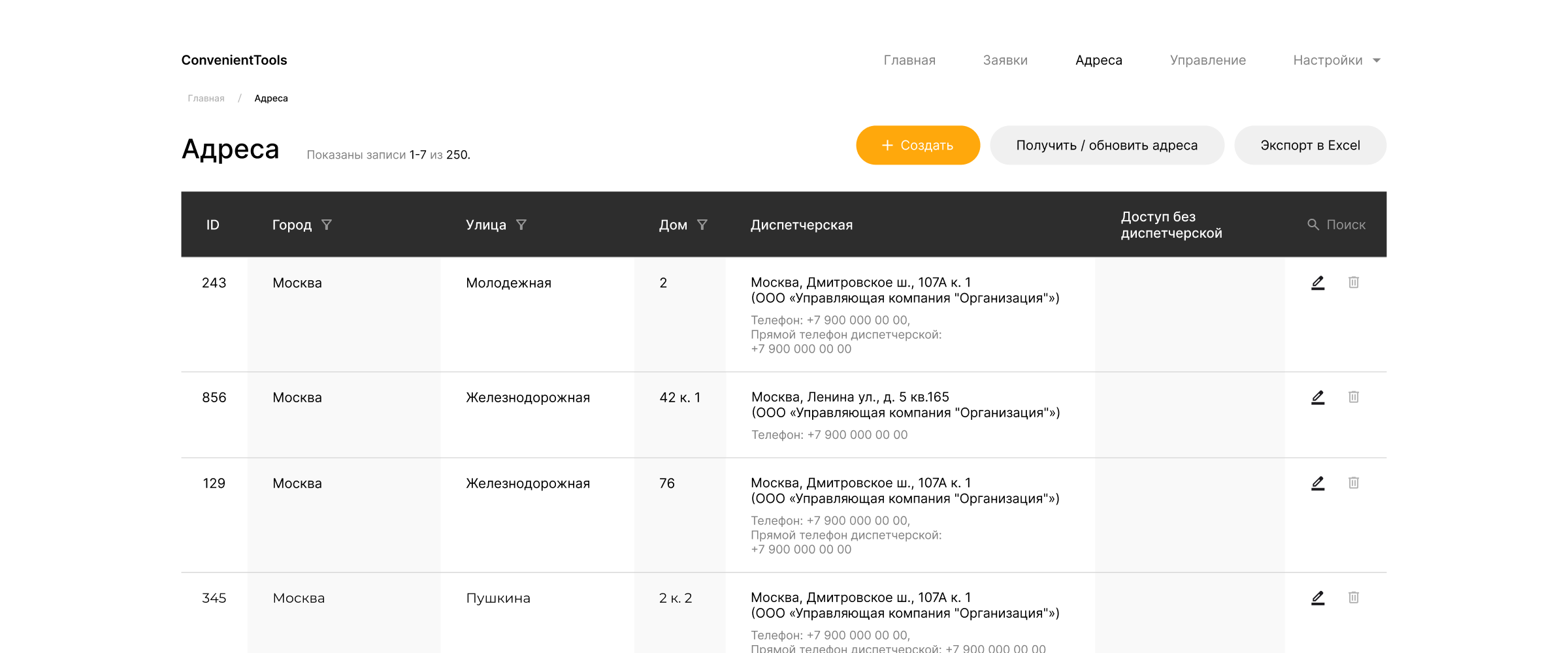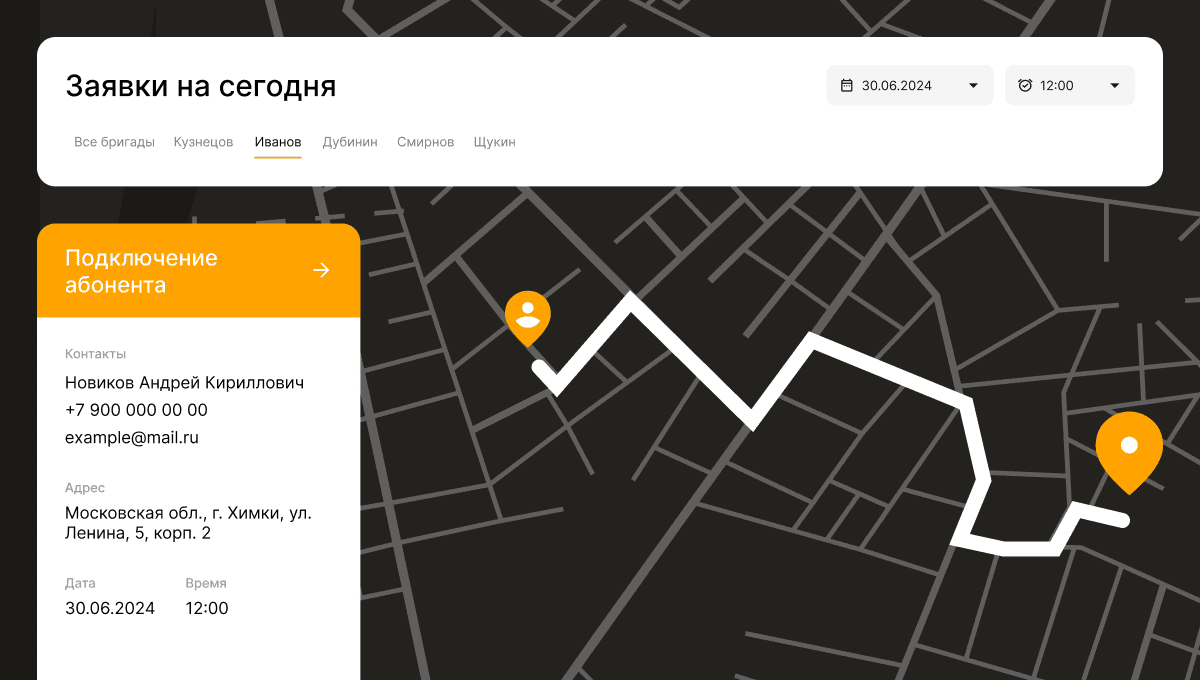PROJECT DURATION: September 2017 – February 2018
PROJECT TEAM (OUTSOURCING): Team Lead, 3 Full-stack Developers
TECHNOLOGIES: PHP, Yii2, PostgreSQL, HTML, CSS, JavaScript, Bootstrap, jQuery, Docker, Docker Compose, Git
PROJECT COST: > 2.5 million rubles
THE CLIENT APPROACHED US
The company has been providing installation services and connecting the Internet, TV, and telephony in Moscow and the Moscow region for over 20 years. It successfully competes in the provider market and is expanding its intra-regional service supply. To implement its strategy, it gradually digitizes business processes and transfers them to web platforms.
Initially, the provider came to us for enhancements to their website's client portal. After configuring the portal's functionality, we learned that the company had more significant issues related to the lack of automation in request processing.
WE UNDERSTOOD THEIR PAIN
All incoming client requests were registered by operators in an off-the-shelf version of Excel. In this program, they also searched for available time slots for specialists and the team that would perform the connection and/or installation work.
It took about 30 minutes for a manager to log an incoming request, find an available slot, assign a team, and manage the logistics. Moreover, to get up-to-date information on the field employees’ schedules, the operator constantly had to request an updated Excel file.
It's hardly necessary to dwell on the drawbacks and inconvenience of using software unsuitable for business purposes, so we immediately set to work.
WE SET THE PROJECT GOAL
To accelerate the processing of incoming orders and subsequent work on requests through an ERP system.
WE IDENTIFIED KEY TASKS
- Step-by-step form for request registration in the system and allocation to teams.
- Functionality for managing and modifying requests.
- Automated service allocation and automatic route determination.
- Centralized storage of information on employees, addresses, management companies (UK), and dispatch services.
- API for future integration with other provider services.
WE ANTICIPATED CHALLENGES
Since the only reference for the future ERP system was an Excel table, we conducted thorough briefings with the provider to delve into work processes and details. We found that the most challenging aspect would be the algorithm for allocating orders to teams and setting routes. However, this would address a significant portion of the company’s needs.
WE FOUND SOLUTIONS AND HERE’S
REQUEST FORM TEMPLATE

Our priority when working with the ERP system was the operator's convenience. To ensure the specialist didn’t miss any important points and could immediately provide the client with a choice of date and time, we created a request acceptance template.
In it, the employee not only logs the primary information about the service order but also immediately schedules it by finding a suitable available slot. The schedule already accounts for the time required to provide the service, which is predetermined based on the company’s experience.
"MANAGEMENT" SECTION

Requests can be edited: rescheduled, data corrected, and tasks added or removed. After edits, the system reminds the operator to notify the client and logs the changes in a separate modification table.
CURRENT REQUESTS AND ROUTE

All service orders are displayed in the "Requests" section. The main page lists the current jobs that need to be completed by the team. In addition to client data and the time interval, there is a Google map showing the navigation from the office to the client's address. It opens when the team is selected. It even considers that for certain types of work, it is necessary to contact the management company and pick up the key to the panel.

To draw the route, the system takes into account the availability of specialists, their work schedule, and the distance from the client’s home/office. A complex allocation algorithm ensures the accuracy of the calculations.
This algorithm also prevents requests from being assigned to employees who cannot fulfill them and suggests the team that is geographically closest to the order location. If nearby specialists are busy, the workload is redistributed, offering other contractors as options.
The action mechanism is designed to maximize the operator's efficiency and minimize human error. The operator practically doesn’t need to think about logistics.
RELATIONAL DATABASE


Entering and storing information in the ERP is a critical part of the order allocation algorithm. The database informs the system about the types and features of tasks, employee schedules, addresses, and contacts of residential complexes (ZHK), dispatch services, and management companies (UK). Data can be created, edited, and deleted. Changes will update schedules, services, and routes.
API
The provider planned to integrate the system with its website and third-party services that receive requests. Therefore, our final ERP refinement included methods and functionality for integrating the system with other platforms.
WE TESTED THE SYSTEM ERP
is an internal company system, so testing was done on both sides. Initially, our team checked the correctness of the functional calculations, after which the provider tested the platform’s behavior in operation. Additionally, we connected a debug panel to catch emerging errors. Developers monitored failures during the implementation of new features and promptly made adjustments, refining the program to perfection.
WE ACHIEVED THE RESULT
Despite the lack of a technical specification, we managed to collaborate productively with the company in a Time & Material format. This allowed us to deeply understand the client's business and offer the tool they needed.
The system's specialized functionality automated request processing, speeding it up tenfold. The well-thought-out algorithm also helped streamline the company's logistics and reduce time spent on route calculations.
For six years now, the Moscow provider has been using the ERP system we developed, only encountering Excel files when exporting data from the system.



